Also Known As
- Meen Curry (മീൻ കറി) – This is the Malayalam name for Kerala Style Fish Curry, commonly prepared with local spices and coconut milk.
- Meen Mulakittathu (മീൻ മുളകിട്ടത്ത്) – Another name in Malayalam that highlights the use of red chili (mulaku) in the curry.
- Nadan Meen Curry (നാടൻ മീൻ കറി) – Refers to traditional Kerala-style fish curry, typically cooked in homes across Kerala.
Ingredients for Kerala Style Fish Curry
Directions for Kerala Style Fish Curry
Soak a small ball of tamarind in warm water for 15-20 minutes. Squeeze the pulp to extract the liquid, discarding the solids. Set aside.
Heat oil in a pan and sauté shallots until golden brown. Remove and set aside. In the same pan, cook tomatoes until softened. Remove and set aside.
In the same pot, cook tomatoes until softened. Remove and set aside.
In the same pot, heat oil, add mustard seeds and fenugreek seeds, let them crackle.
Add ginger, garlic, curry leaves, and green chili. Sauté until fragrant.
Add turmeric, coriander, and red chili powder. Sauté until aromatic.
Mix in the shallot-tomato paste, then add tamarind water and salt.
Stir to combine, cover, and boil for 6-7 minutes.
Add mackerel fish, gently shake the pot to coat the fish, cover, and cook until the fish is done, occasionally shaking the pot. Remove from heat.
Heat oil in a tempering pan, add mustard seeds and let them crackle.
Add shallots and dry red chilies, frying until shallots are golden. Add curry leaves and mix.
Pour the tempering over the fish curry, give the pot a final shake.
Kerala style fish curry with Mackerel is ready to serve.
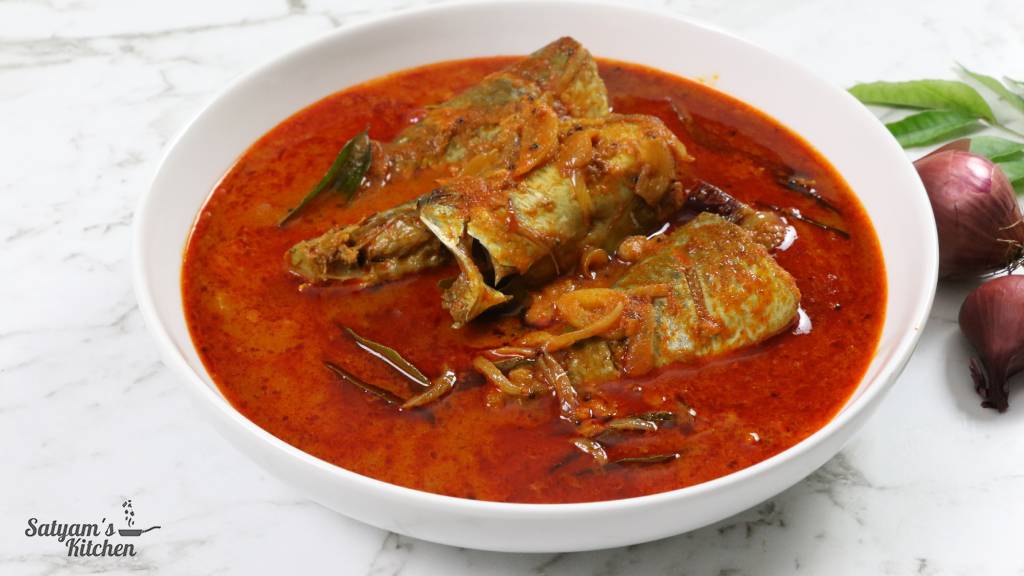
Ingredients
Directions
Soak a small ball of tamarind in warm water for 15-20 minutes. Squeeze the pulp to extract the liquid, discarding the solids. Set aside.
Heat oil in a pan and sauté shallots until golden brown. Remove and set aside. In the same pan, cook tomatoes until softened. Remove and set aside.
In the same pot, cook tomatoes until softened. Remove and set aside.
In the same pot, heat oil, add mustard seeds and fenugreek seeds, let them crackle.
Add ginger, garlic, curry leaves, and green chili. Sauté until fragrant.
Add turmeric, coriander, and red chili powder. Sauté until aromatic.
Mix in the shallot-tomato paste, then add tamarind water and salt.
Stir to combine, cover, and boil for 6-7 minutes.
Add mackerel fish, gently shake the pot to coat the fish, cover, and cook until the fish is done, occasionally shaking the pot. Remove from heat.
Heat oil in a tempering pan, add mustard seeds and let them crackle.
Add shallots and dry red chilies, frying until shallots are golden. Add curry leaves and mix.
Pour the tempering over the fish curry, give the pot a final shake.
Kerala style fish curry with Mackerel is ready to serve.
Notes
Main Ingredients for Kerala Style Fish Curry
- Mackerel (ആയല / Ayala): This is the star of the dish, providing a rich and meaty texture. Mackerel is a flavorful fish that absorbs the spices and flavors of the curry beautifully.
- Shallots: These small, sweet onions add a distinct flavor to the curry. They are sautéed to release their natural sweetness and aroma, forming the base of the curry sauce.
- Tomato: Tomatoes lend a tangy sweetness and a slight acidity to the curry. They are cooked until soft and then blended with the shallots to create a smooth puree.
- Mustard Seeds and Fenugreek Seeds: These spices are tempered in hot oil to release their aromatic flavors. Mustard seeds provide a slight heat, while fenugreek seeds add a hint of bitterness.
- Ginger and Garlic: These aromatic ingredients add depth and complexity to the curry. They are finely minced or grated and sautéed until fragrant.
- Curry Leaves: These leaves are a staple in South Indian cooking and add a unique flavor and aroma to the curry. They are added to the hot oil along with the other spices.
- Green Chilies: These provide heat and spice to the curry. They can be adjusted according to taste preferences.
- Turmeric, Coriander, and Red Chili Powder: These ground spices are essential for flavoring the curry. Turmeric adds a golden hue, coriander adds earthiness, and red chili powder provides heat.
- Tamarind Water: Tamarind water adds a tangy flavor to the curry, balancing the spices and enhancing the overall taste.
- Salt: Salt is used to season the curry, bringing out the flavors of the other ingredients.
Serving Suggestions for Fish Curry without Coconut Milk
This Fish Curry pairs wonderfully with steamed white rice. The tangy and spicy flavors of the curry complement the mild and fluffy texture of the rice, making it an ideal base to soak up all the rich gravy. Additionally, it can be served with traditional Kerala sides like appam or puttu, which enhance the authentic experience. For a balanced meal, consider adding a side of sautéed vegetables or a fresh cucumber salad to offset the spiciness. To complete the meal, a serving of pappadam adds a delightful crunch.
Tips for Kerala Style Fish Curry without Coconut Milk
- Choose Fresh Mackerel: Opt for fresh mackerel that has a bright and clear appearance with firm flesh. Fresh fish will impart the best flavor to your curry.
- Clean the Fish Thoroughly: Ensure that the mackerel is cleaned thoroughly, removing any scales, guts, and fins. Rinse the fish under cold water and pat dry with paper towels before cooking.
- Adjust Spice Levels: Adjust the quantity of green chilies and red chili powder according to your spice preference. If you prefer a milder curry, reduce the amount of chili used.
- Temper the Spices Properly: Take care when tempering the mustard seeds and fenugreek seeds to avoid burning them. Use medium heat and remove the pan from the heat as soon as the seeds start to crackle.
- Grind the Shallot-Tomato Puree Smoothly: Ensure that the shallots and tomatoes are ground into a smooth puree to achieve a silky texture in the curry.
- Use Fresh Curry Leaves: Fresh curry leaves impart a distinct flavor to the curry. If possible, use fresh curry leaves rather than dried ones for the best taste.
- Simmer the Curry: Allow the curry to simmer gently after adding the fish. This allows the flavors to meld together and ensures that the fish cooks evenly without falling apart.
- Check for Doneness: To check if the fish is cooked, gently insert a fork into the thickest part of the fish. If it flakes easily and is opaque throughout, it is done.
- Adjust Seasoning: Taste the curry before serving and adjust the seasoning if necessary. You can add more salt or tamarind water to balance the flavors according to your taste.
- Rest Before Serving: Allow the curry to rest for a few minutes before serving. This allows the flavors to develop further and ensures a more flavorful dish.
Storage Tips for Fish Curry
Store leftover fish curry in an airtight container in the refrigerator for up to 2-3 days. Reheat gently on the stovetop or in the microwave before serving.
People Also Ask About Kerala Style Fish Curry
Q. Can I use frozen mackerel for this fish curry recipe?
A: Yes, you can use frozen mackerel if fresh fish is not available. However, thaw the fish thoroughly in the refrigerator before using it in the recipe.
Q. How do I adjust the spice level of the curry?
A: You can adjust the spice level by varying the quantity of green chilies and red chili powder used in the fish curry recipe. For a milder curry, reduce the amount of chili or omit it entirely.
Q. Can I substitute curry leaves with dried ones?
A: While fresh curry leaves are preferred for their distinct flavor, you can use dried curry leaves if fresh ones are not available. However, the flavor may not be as intense.
Q. How do I make tamarind water?
A: To make tamarind water, soak a small ball of tamarind in warm water for about 15-20 minutes. Then, squeeze the tamarind pulp to extract the liquid, and discard the solids.
Q. What should I serve with Kerala Style Mackerel Fish Curry?
A: This curry pairs well with steamed rice, appam (rice pancakes), or dosa (savory crepes). You can also serve it with chapati or crusty bread for a delicious meal.
Recipe Suggestions
If you like this fish curry recipe, you might also like Kottayam Style Fish Curry.
Here are other Kerala recipe suggestions:
Kerala Egg Roast
Kerala Egg Curry
Have you tried this recipe?
Mention us @satyamskitchen and tag #satyamskitchenrecipes
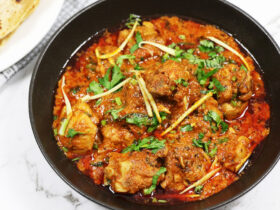
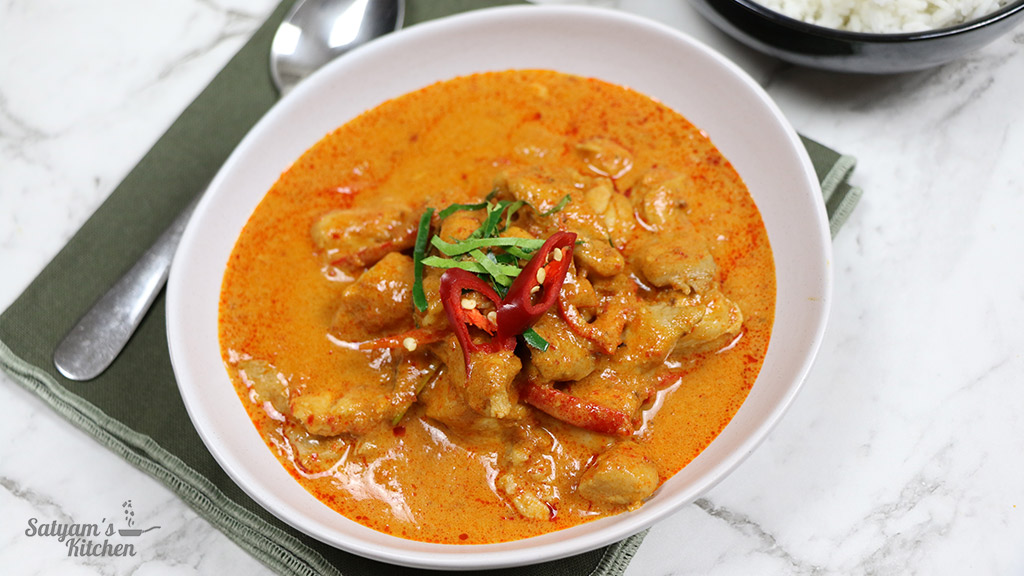
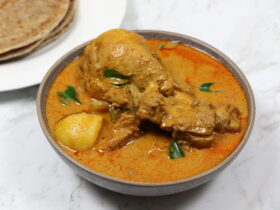




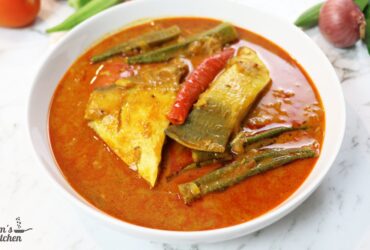
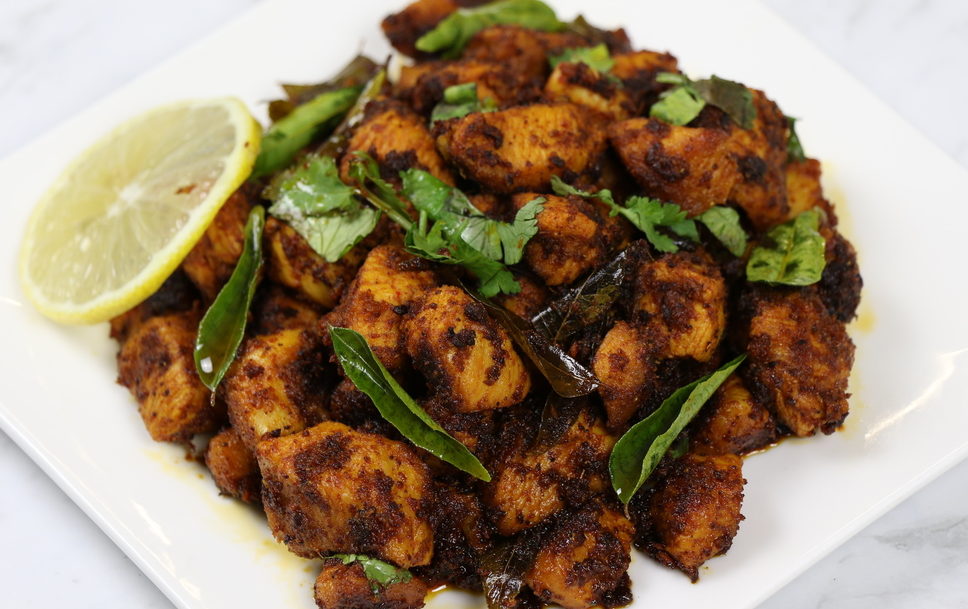
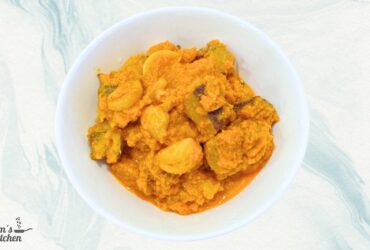
Leave a Review